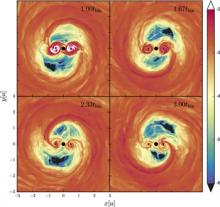
Abstract
We present the first magnetohydrodynamic simulation in which a circumbinary disk around a relativistic binary black hole feeds mass to individual accretion disks ("mini-disks") around each black hole. Mass flow through the accretion streams linking the circumbinary disk to the mini-disks is modulated quasi-periodically by the streams' interaction with a nonlinear m=1 density feature, or "lump", at the inner edge of the circumbinary disk: the stream supplying each mini-disk comes into phase with the lump at a frequency 0.74 times the binary orbital frequency. Because the binary is relativistic, the tidal truncation radii of the mini-disks are not much larger than their innermost stable circular orbits; consequently, the mini-disks' inflow times are shorter than the conventional estimate and are comparable to the stream modulation period. As a result, the mini-disks are always in inflow disequilibrium, with their masses and spiral density wave structures responding to the stream's quasi-periodic modulation. The fluctuations in each mini-disk's mass are so large that as much as 75% of the total mini-disk mass can be contained within a single mini-disk. Such quasi-periodic modulation of the mini-disk structure may introduce distinctive time-dependent features in the binary's electromagnetic emission.